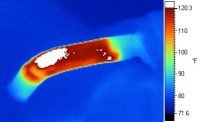I can make a schematic next week when I'm back in the office. But there's not a lot to it - or I couldn't have done it.
*** Do this for each side ***
After you've installed the heater element on the grip, twist the RED and BLUE leads together. Then connect this pair to one of the wires that fed the stock grip heaters. Connect the WHITE lead to the other wire of the stock grip circuit. Note: You'll need to add wire to both lines (RED/BLUE and WHITE) in order to reach the stock grip connectors under the hood.
I am pretty sure that I will add another small resistor on one line of each heater just to knock the current draw down a little bit. The 6.6 amps I saw might be more current than needed. I'll include this resistor placement in the schematic.
Now, just to prove my ignorance of all things electrical; does it matter on a DC circuit which side of the heater element goes to ground? I'm thinking it doesn't.
















